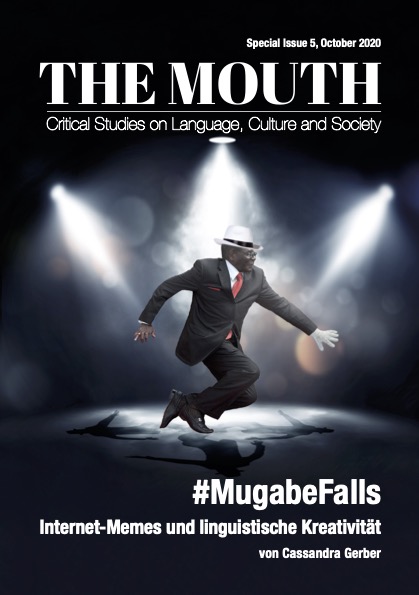#MugabeFalls - Internet-Memes und linguistische Kreativität
DOI:
https://doi.org/10.18716/ojs/the_mouth.3180Abstract
Der virtuelle Raum bietet viele Möglichkeiten sich auszudrücken. Eine dieser Möglichkeiten sind Internet-Memes. Das können Bilder, Texte, Audiodateien, oder Videos sein, welche innerhalb einer Diskursgemeinschaft miteinander erstellt, verändert und geteilt werden. Dies geschieht vor allem auf sozialen Plattformen im Internet, kann aber auch in Chatprogrammen wie zum Beispiel „Whatsapp“ für Mobiltelefone in einem privaten Rahmen geschehen.
Exemplarisch verhandelt wird hier ein Internet-Meme, welches ich im Folgenden als das „Mugabe-Meme“ bezeichne. Dieses Meme entstand auf Grund eines Sturzes im Jahr 2015 am Flughafen in Harare des ehemaligen Präsidenten von Simbabwe, Robert Mugabe. Dieser war von 1987 bis 2017 im Amt des Präsidenten und zunehmend Kritik innerhalb und außerhalb seines Landes aufgrund seiner teilweise von Korruption und Polizeigewalt geprägten Politik ausgesetzt. Das Internet-Meme verhandelt wie bereits erwähnt einen Sturz des ehemaligen Präsidenten, da dieser gestolpert war. Während dieses Sturzes wurde er im Moment des Falls fotografiert. Dieses Foto wurde wiederrum verboten und die Journalist*innen vor Ort gezwungen, es von den Kameras zu löschen. Das Bild tauchte dennoch am selben Tag im Internet auf. Robert Mugabe wurde meistens mithilfe einer Bildbearbeitungssoftware ausgeschnitten und vielfach in neue Bildkontexte gesetzt. Das Internet-Meme erreichte globale Aufmerksamkeit und wurde in verschiedenen Medien thematisiert. Für mich ist einerseits interessant, wie man das Internet-Meme generell in einen Forschungskontext einbetten kann. Andererseits möchte ich untersuchen, in welcher Form das Internet-Meme als Ausdruck linguistischer Kreativität gedeutet werden kann. Hiermit ist im Folgenden nicht nur die kreative sprachliche Handlung im Sinne eines „engen“ Sprachbegriffs gemeint: Es geht nicht um Äußerungen. Unter „Sprache“ werden hier auch unter anderem Bildsprache und auch „Texte“ mit einbezogen.

Downloads
Published
Issue
Section
License

This work is licensed under a Creative Commons Attribution 4.0 International License.
CC BY 4.0 deed
https://creativecommons.org/licenses/by/4.0/deed.en
You are free to:
- Share — copy and redistribute the material in any medium or format for any purpose, even commercially.
- Adapt — remix, transform, and build upon the material for any purpose, even commercially.
- The licensor cannot revoke these freedoms as long as you follow the license terms.
Under the following terms:
- Attribution — You must give appropriate credit , provide a link to the license, and indicate if changes were made . You may do so in any reasonable manner, but not in any way that suggests the licensor endorses you or your use.
- No additional restrictions — You may not apply legal terms or technological measures that legally restrict others from doing anything the license permits.
Notices:
You do not have to comply with the license for elements of the material in the public domain or where your use is permitted by an applicable exception or limitation .
No warranties are given. The license may not give you all of the permissions necessary for your intended use. For example, other rights such as publicity, privacy, or moral rights may limit how you use the material.Notice
This deed highlights only some of the key features and terms of the actual license. It is not a license and has no legal value. You should carefully review all of the terms and conditions of the actual license before using the licensed material.
Creative Commons is not a law firm and does not provide legal services. Distributing, displaying, or linking to this deed or the license that it summarizes does not create a lawyer-client or any other relationship.
Creative Commons is the nonprofit behind the open licenses and other legal tools that allow creators to share their work. Our legal tools are free to use.





